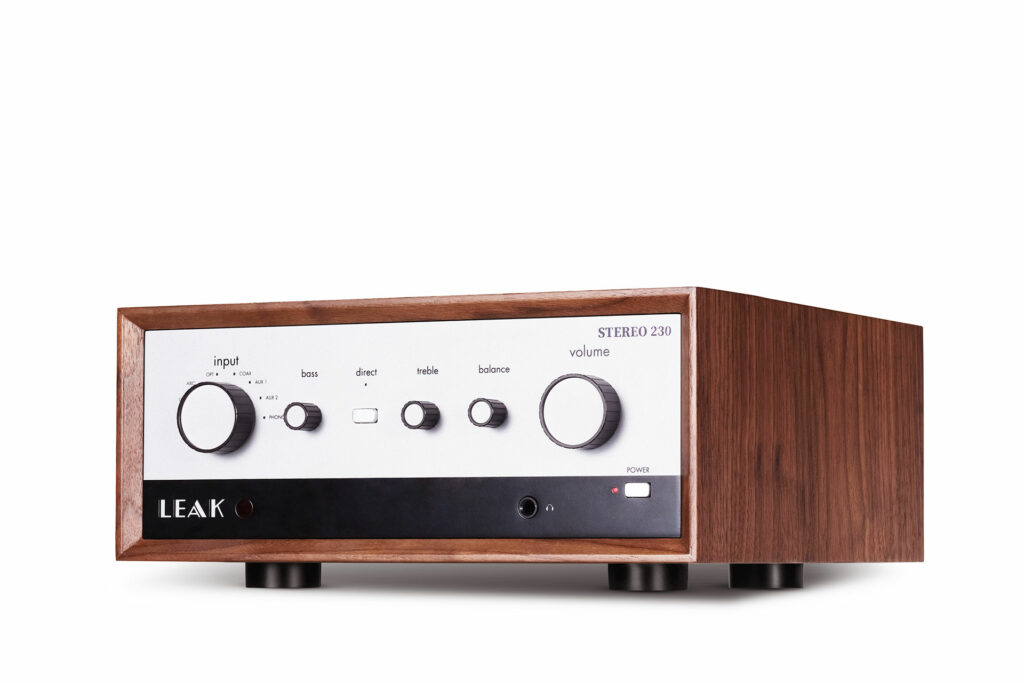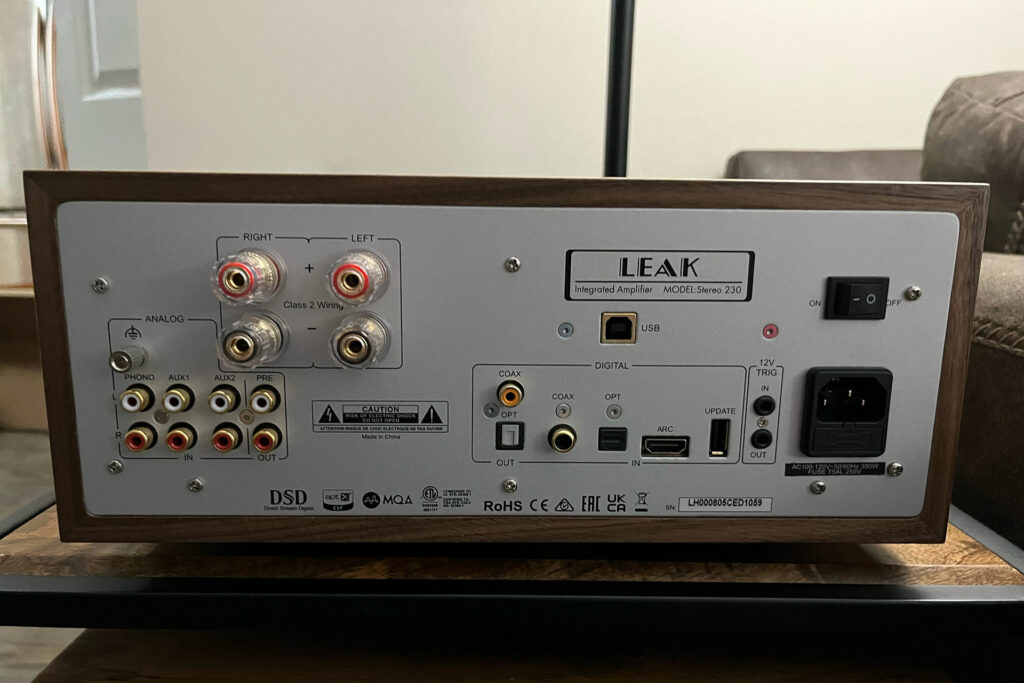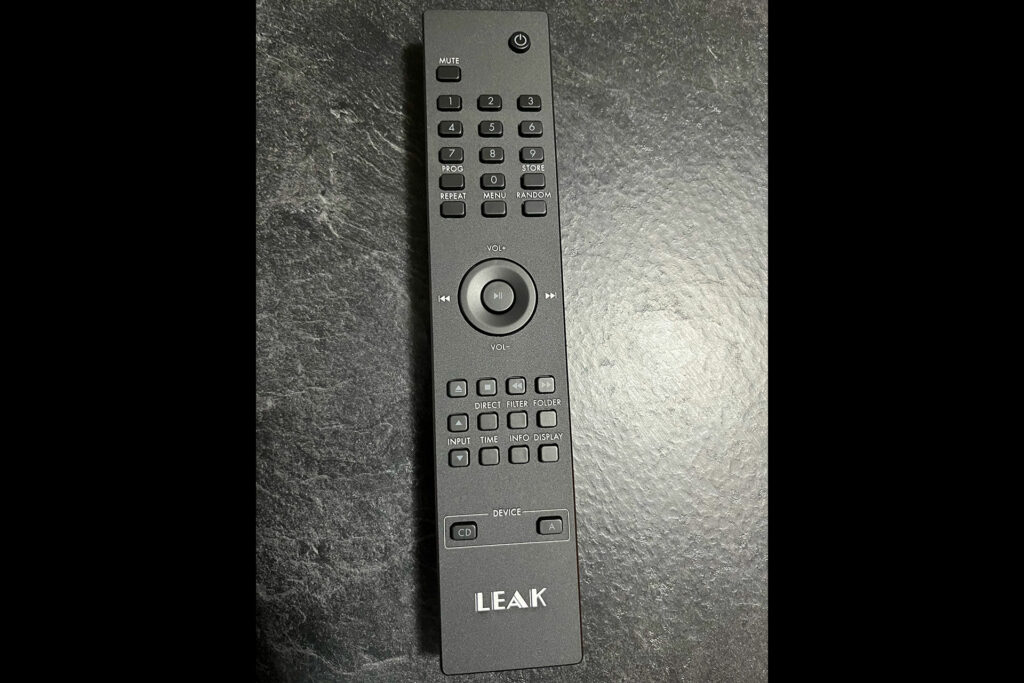The Stereo 230 from Leak is a modern take on a heritage design from the English audiophile brand Leak, which has been making high-performance components since 1934. This $1,695 integrated amp is designed to look similar to the Stereo 30, which came out in 1963. Outside of the visual design, this is where the retro inspired portions come to a stop. The integrated amplifier features 115 watts of Class AB power per channel at four ohms, and 75 watts into eight ohms. It also features a 32-bit ES909038Q2M DAC, an HDMI input, AptX Bluetooth support, a USB-B input, two optical inputs, a digital COAX input, two RCA inputs, a moving magnet phono stage, and an RCA pre out if you wish to use the integrated amplifier as a preamplifier and a headphone jack. All of this makes for a very modern package built into a retro-looking design.

What Makes the Leak Stereo 230 Integrated Amplifier Special?
- If you’re looking for modern features with a vintage look, the Leak Stereo 230 audiophile integrated amp is for you. Everything from the walnut finish to the faceplate on the front provides this integrated amplifier with a vintage look that is comparable to the original unit it was named after.
- The Leak Stereo 230 has all the features you could want in a modern integrated amplifier. In this package, you are getting HDMI ARC, digital coax, and optical inputs, as well as the 32-bit DAC on the digital side of things, and then two RCA inputs, and a moving magnet phono stage on the analog side of the house.
- 115 watts of Class AB power in an integrated amp is great to have. With more and more integrated amps going to Class D power, there is going to be a group of people who will always prefer the sound of Class AB power.
Why Should You Care About the LEAK Stereo 230 Integrated Amplifier?
If you are seeking a retro-looking integrated amplifier with a decent amount of power that can handle everything in your listening space (HDMI in for your television, a high-res DAC, digital inputs – coaxial, USB, and optical – analog inputs, and a phono stage), then you should be looking at the LEAK Stereo 230. The power output that the amplifier produces shouldn’t be scoffed at, either. To get up to 115 watts of Class AB power out of a box that weighs just 28 pounds and is only 12.83 x 5.74 x 16.2 inches in size is a real feat. I also didn’t notice any meaningful heat coming from the unit, either physically to touch or with clipping or distortion in the sound.

Some Things You Might Not Like About the LEAK Stereo 230 Integrated Amplifier
- The sound that the LEAK Stereo 230 creates has a warmth to it. It wasn’t something I noticed right away, but after I did some A/B testing with my Anthem STR Preamp (buy at Crutchfield) and Anthem MCA 225 Gen 2 amplifier (buy at Crutchfield), I could hear how much warmer the LEAK sounded by comparison. This is a matter of debate among audiophiles, some of whom like the warm sound, while others suggest that electronics shouldn’t impart a sonic “flavor” whatsoever on the signal. I didn’t mind the sound at all, but I did have to make mention of it.
- The actual switching between inputs can be a little slow. On many occasions, I found myself waiting more than a few seconds for the amplifier to switch inputs. I would turn the dial at the front, but nothing would happen, so I would have to go back and do it again. This was mostly at start-up, and I did get used to it, but it would have been nice for the light to have had a different color when the input wasn’t ready to be changed, so that you would have a visual indication of when the integrated amplifier was ready for you to change the input.
- The remote control felt cheap and physically oversized. I understand the size to some extent, as you need it to perform many functions, so you can switch between the various inputs, but when the size nearly reaches the length of my forearm, I think there is some slack that could have been cut. The remote is plastic, and I had real concerns that if it was to be knocked off my coffee table a few times, I would be at risk of breaking it. Now, you don’t need the remote control, as you can control everything from front of the LEAK Stereo 230, but it is nice to be able to adjust the volume from the listening position.
Listening to the LEAK Stereo 230 Integrated Amplifier…
I performed my testing with the LEAK Stereo 230, the Martin Logan Motion XT F100 floorstanding speakers (read the review), a Pro-Ject X1 B turntable (buy at Crutchfield) and a Sonos Port (read the review), using the digital coax input to test the DAC.
One of the tracks that stood out to me while listening to the LEAK 230 was Eric Clapton’s After Midnight from his 2021 release The Lady in the Balcony: Lockdown Sessions, which I listened to on vinyl with the built-in phono section. This album is one of the best new recordings that I have heard in recent memory, and it in many ways serves as Clapton revisiting his Unplugged classics. At the start of the track, the stand-up bass being played by Nathan East comes through strong, and you can not only feel the bass, but feel how it is setting the tone for the rest of the track before Clapton and the rest of the band come in. The phono section of the integrated amplifier allows the track to have plenty of dynamics as you go from that bass sound to Clapton’s acoustic guitar.
If you have read enough of my reviews, you know that I love modern jazz. In this case, “Raisins Under the Sun” by Yussef Dayes from his album Black Classical Music provides such a great vibe. The implementation of the ES9038Q2M DAC does a wonderful job of providing separation among the instruments, while still having the band sound tight-knit. Dayes’ drumming is varied and sets the tone with reggae beat before settling into a more traditional jazz beat along the way. There is so much to hear on this track that I found myself having to keep going back for more, as there were so many details to be found that I couldn’t take all of it in by just listening to the track a handful of times. That is what a good audiophile component will deliver to your listening experience, thus this is a very good sign.
“The Same” is an electronic track from the band The Smile off their debut album A Light for Attracting Attention. I streamed this through Qobuz at Hi-Res 44.1 kHz. This track is very dense, full of different sounds from keyboards, while the drum beat sits in the background. We shouldn’t expect much less from Thom Yorke and Johnny Greenwood (both members of Radiohead). Greenwood has worked on nearly more soundtracks at this point than he has rock albums, and you can hear that experience in this track as well. The LEAK Stereo 230 represented this music quite well. The DAC reproduced those layers in a way that added clarity, and in no way muddied the sounds that were being reproduced. The warmth added by the amplifier was more noticeable on this track than the others, but it seemed to help the electronic nature of this music, as it softened the edges from the otherwise sharp sounds coming from the various keyboards.
Does the Leak Stereo 230 Integrated Amplifier Have Any Resale Value?
A lot will depend on how the market takes to LEAK as a brand in the United States under distribution by MoFi, but this unit has all of the features that you would expect from an integrated amplifier, and some future-forward features as well, such as HDMI ARC, to go along with plenty of power output. I would expect the Stereo 230 to hold its value both now and into the future, as this is the type of product that can gain its own niche following because of its retro vibe and modern features.

Who Is the Competition For the Leak Stereo 230 Integrated Amplifier?
The strongest competition to the LEAK Stereo 230 is the NAD C 3050 ($1,399 – buy at Crutchfield). It has a similar retro look to it, and it features room correction, which is a big perk, and you can upgrade it to have BluOS built-in, which is another major plus. The difference here is that the NAD is larger and uses Class D power, so it comes with a different, more neutral sound. If you’re going to be looking at the LEAK Stereo 230, I would recommend checking out the NAD as well. I reviewed it recently, and it is also well worth your time, as this was our 2023 Product of the Year winner out of everything that we reviewed.
If you’re looking for something with a modern appearance, the Marantz Model 50 ($1,800 – buy at Crutchfield) is an integrated amplifier that should be worth consideration. Marantz has a sound history of making quality audiophile products, and this integrated amplifier has many of the same features as the LEAK Stereo 230. Brian Kahn reviewed the Marantz Model 30 (buy at Crutchfield), and he had nothing but good things to say about it, so I wouldn’t expect much different from the smaller but also nifty Marantz Model 50.
If you’re budget is a little smaller, but you’re looking for a similar feature set, you can also explore the SVS Prime Wireless Pro SoundBase ($699 – buy at Crutchfield). This unit has HDMI, streaming built-in, and provides 150 watts of Class D power into four ohms. It doesn’t have the same visual appeal, but it is a strong package at that price. My esteemed colleague Michael Zisserson reviewed this a few months back, and felt like it was a solid value at its price point.

Final Thoughts on the Leak Stereo 230 Integrated Amplifier…
While the LEAK Stereo 230 has some little quirks, this was ultimately an integrated amplifier that I really enjoyed my time with. The sound it provided was warm by comparison, but it wasn’t something that I found that I disliked across what I suspect is more than 100 hours of listening.
The DAC and phono section worked well and enhanced the sound of the recordings they were reproducing, and the amplifier provided more than enough power to crank up the volume on my favorite tracks. This is an integrated amp that worked well with any number of speakers, both large and small, in my system today. The pleasing sound might not come from a new-school, bleeding-edge Class D amp, but it makes all of your music sound just a little bit more approachable and, at this price point, I am saying that this is a good thing. There is strong competition in the retro receiver market, but make room for another player from Leak with the Stereo 230. This is a rock-solid, audiophile-grade integrated amp at a very fair price.




It was a real pleasure to read your article: it is honest and to the point. I am looking for an amp. tot play with KEF q950 and maybe this Leak is the one for me.
Although I am afraid that the device does not deliver the quantity of power needed for the KEF or do I make a mistake.? Anyway, thank you very much for this article and I have learned a lot.
By the way, I am 82
Thanks for your comment.
The guys from MOFI will be super excited to see you ready to buy one of the lines that they sell and promote…
🙂
Jerry